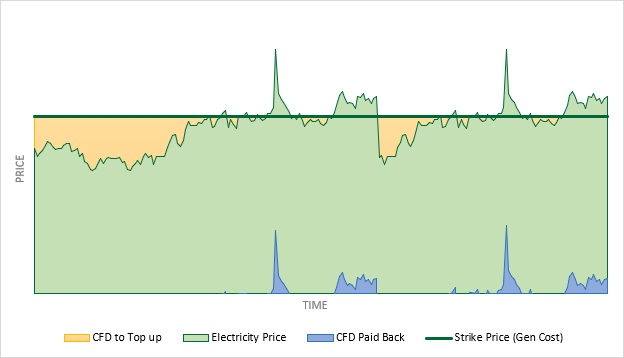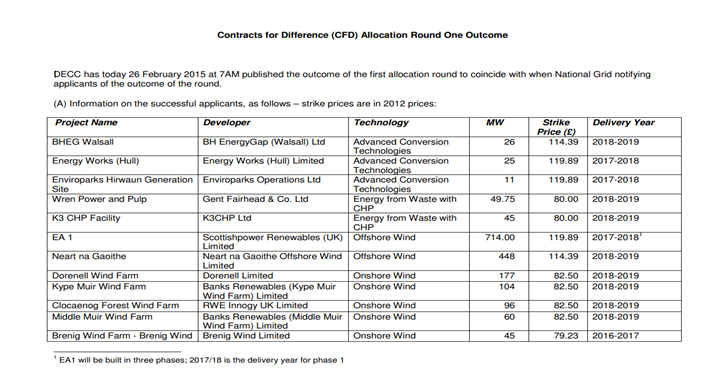The Electricity Market Reform (EMR) aimed to deliver low carbon energy whilst maintaining security of supply and minimising the cost to the consumer. One of the mechanisms to do this was the Contract for Difference (CfD) scheme, which replaced the Renewables Obligation as the support mechanism for renewable generation.
The UK wholesale electricity market is volatile, and as investors require a predictable return on their investments, this historically made investment in new renewable generation unattractive versus other investment opportunities. To overcome this barrier, the CfD scheme was created to guarantee a minimum price for the electricity generated by a project.
Contracts are awarded via auction. The UK government established the Low Carbon Contracts Company (LCCC) to manage the auctions into which low carbon generators can bid to receive a CfD, which is a private contract between the generator and the LCCC. The Department of Energy & Climate Change (DECC) set the budget for each allocation round, with the budget being split into three pots: one for established technologies, two for less established technologies and three for biomass conversion.
Under a CfD, the generator agrees a ‘strike price’ for their generation, which is reflective of the cost of investing in a particular low carbon technology. The generator is then paid the difference between the ‘strike price’ and the ‘reference price’, which is a measure of the average wholesale market price for electricity in the GB market. If the reference price is below the strike price, then the generator receives a ‘top-up’ to the agreed strike price from the scheme. If the reference price is higher than the strike price then the generator pays into the scheme the difference between the reference price and the strike price. This is shown in the diagram below.

The scheme is designed to incentivise investment in renewable generation whilst protecting consumers from excessive costs. The generator obtains a guaranteed price once the project is operational, but foregoes the opportunity to make excessive upside profits in return for protection against any wholesale market prices which are below their investment costs. This gives the project a predictable and stable revenue stream which it can then take to potential investors.
To date, there have been four auction rounds for renewable generators to bid into to receive a CfD. The recent auction ended on 13th December 2021, with the results announced on 7th July 2022. Each auction details the strike-price agreed between the renewable generation developer and LCCC.
Under the scheme, the renewable generator still sells the electricity generated into the wholesale energy market as usual, but receives a top-up to the agreed strike price from the LCCC. The top-up payment is funded by a levy on electricity suppliers under the Contracts for Difference (Electricity Supplier Obligation) Regulations 2014 and is therefore ultimately paid for by the consumer.
The details of contracts awarded in each round can be found at the following locations:
1st Round Allocations
Contract for Difference – Auction Results 1
2nd Round Allocations
Contract for Difference – Auction Results 2
3rd Round Allocations
Contract for Difference – Auction Results 3
4th Round Allocations
Contract for Difference – Auction Results 4
Analysing the results, it is clear that the amount of support required by technologies has reduced as technologies mature. In a number of auctions, certain types of technology have been omitted entirely, such as onshore wind in auction round two.
Below is an extract from the round one allocation auction.

The strike price in the table above is the agreed price between the renewable energy generator and the LCCC. In the initial pandemic and early 2021, the wholesale market was below the strike prices, meaning those generators with a CfD would be receiving top-up payments levied through consumer bills. However, since late 2021, the wholesale energy price has been significantly above the strike price, meaninggenerators have been paying into the scheme. This means payment through supplier invoices has fallen to almost zero.
The scheme does not allow for the value recovered through supplier invoices to fall below zero. Instead, the surplus generated from the generators will be held in a fund, to keep the amount charged through invoice close to zero until such time the fund dries up. This will only occur when the wholesale market price falls below the strike price agreed with the generators.
